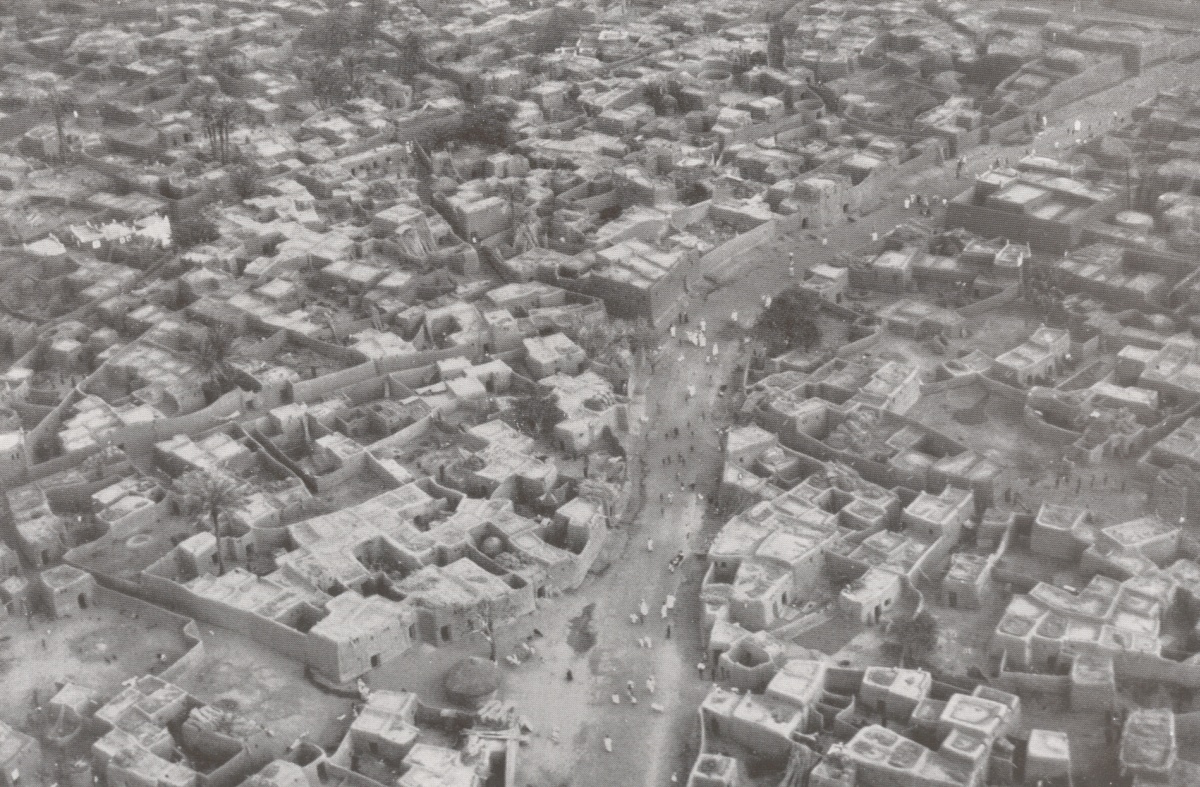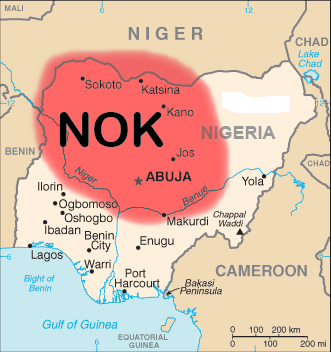|
Barbushe
Barbushe was a hunter and pagan chief priest who was the most prominent leader of the indigenous animists of Dala, a place which would become the most important site in the history of the foundation of Kano, now a state in Northern Nigeria. Background Barbushe was the son of Buzame, who was the son of Garageje, who was one of the four sons of Dala. Dala was one of the first settlers around Dala Hill who came after the blacksmith, Kano, found iron ore and fertile land there. Dala is responsible for the refinement of the pagan religion, using his extensive knowledge of cultures and religions around the world to create a more sophisticated form of idol worship, which was heavily laced with middle eastern lore. The city of Dala and the Dala Hill are named after him. Description Barbushe was said to be a man of enormous stature. He was exceptionally strong and a skilled hunter who would kill elephants with his stick and carry them on his back for miles. Chief Priest of Tsumburbur ... [...More Info...] [...Related Items...] OR: [Wikipedia] [Google] [Baidu] |
Dalla Hill
Dalla Hill (also spelled Dala) is a hill in Kano, Kano State, Nigeria. It is high and contains a stairway with 101 steps to the bottom to top. In the seventh century, the hill was the site of a community that engaged in iron-working. It was called the Tsumburbura shrine from 700 CE up until the credo's collapse as a result of Islamic dominance later in the 13th century. Kano was originally known as Dala, after the hill. History The hill is a crucial part of the history of the city of Kano. It is believed that Barbushe, a man of great stature and might who hunted elephants with his stick and carried them on his back to the hill, resided there hundreds of years ago. It said that there, Barbushe built a shrine to worship a deity called Tsumburbura who is believed to have been worshipped by the Hausa people at the time before the arrival of Islam. The only person that was allowed access to the shrine was Barbushe; anyone that entered it without his permission is said to have died ... [...More Info...] [...Related Items...] OR: [Wikipedia] [Google] [Baidu] |
Kingdom Of Kano
The Kingdom of Kano was a Hausa kingdom in the north of what is now Northern Nigeria that dates back before 1000 AD, and lasted until the proclamation of the Sultanate of Kano by King Ali Yaji Dan Tsamiya in 1349. The kingdom was then replaced by the Sultanate of Kano, under the suzerainty of a Muslim Sultan The capital is now the modern city of Kano in Kano State. Location Kano lies to the north of the Jos Plateau, located in the Sudanian Savanna region that stretches across the south of the Sahel. The city lies near where the Kano and Challawa rivers flowing from the southwest converge to form the Hadejia River, which eventually flows into Lake Chad to the east. The climate is hot all year round. Rainfall is variable, ranging from 350mm to 1,300mm annually with the mean around 950mm, almost all falling during June–September period. Traditionally agriculture was based on lifting water to irrigate small parcels of land along river channels in the dry season, known as the Sha ... [...More Info...] [...Related Items...] OR: [Wikipedia] [Google] [Baidu] |
Dala, Kano
Dala is a densely populated Local Government Area in Kano State, Nigeria within Kano city created in May, 1989 from the old Kano Municipal Local Government. It is located in the north-west part of the Kano metropolis. Its headquarter is in Gwammaja. History It contains Dalla Hill from which it got its name and was once the capital of the Sultanate of Kano. Geography It has an area of 19 km and a population of 418,777 as at the 2006 census. It is thus the largest Local Government Area in Nigeria. The postal code of the area is 700. Economy Among popular economic and commercial activities in Dala are dyeing, black smith, local bread making, pot making, farming, fishing, shoe making and other commercial undertakings. Politics The Local Government is dubbed in ( ha, Cibiyar Dimokaraɗiyyar Najeriya) meaning 'the Democratic Centre of Nigeria'. Education One of Nigeria's unity schools, the Government Girls College is in Dala. Personalities It is the residential place of ... [...More Info...] [...Related Items...] OR: [Wikipedia] [Google] [Baidu] |
Kano State
Kano State (Hausa: ''Jihar Kano''جىِهَر كَنوُ) (Fula: Leydi Kano 𞤤𞤫𞤴𞤣𞤭 𞤳𞤢𞤲𞤮𞥅 ) is one of the 36 states of Nigeria, located in the northern region of the country. According to the national census done in 2006, Kano State is the most populous in Nigeria. The recent official estimates taken in 2016 by the National Bureau of Statistics found that Kano State was still the largest state by population in Nigeria. Created in 1967 from the former Northern Region, Kano State borders Katsina State to the northwest, Jigawa State to the northeast, Bauchi State to the southeast, and Kaduna State to the southwest. The state's capital and largest city is the city of Kano, the second most populous city in Nigeria after Lagos. The incumbent governor of the state is Abdullahi Umar Ganduje. He was sworn in on May 29, 2015. Modern day Kano State was the site of numerous kingdoms and empires, including the Kingdom of Kano, which was centered in Dalla Hil ... [...More Info...] [...Related Items...] OR: [Wikipedia] [Google] [Baidu] |
Northern Region, Nigeria
Northern Nigeria was an autonomous division within Nigeria, distinctly different from the southern part of the country, with independent customs, foreign relations and security structures. In 1962 it acquired the territory of the British Northern Cameroons, which voted to become a province within Northern Nigeria. In 1967, Northern Nigeria was divided into the North-Eastern State, North-Western State, Kano State, Kaduna State, Kwara State, and the Benue-Plateau State, each with its own Governor. History Prehistory The Nok culture, an ancient culture dominated most of what is now Northern Nigeria in prehistoric times, its legacy in the form of terracotta statues and megaliths have been discovered in Sokoto, Kano, Birinin Kudu, Nok and Zaria. The Kwatarkwashi culture, a variant of the Nok culture centred mostly around Zamfara in Sokoto Province is thought by some to be the same or an offshoot of the Nok. The Fourteen Kingdoms The Fourteen Kingdoms unified the diverse ... [...More Info...] [...Related Items...] OR: [Wikipedia] [Google] [Baidu] |
Byzantine Empire
The Byzantine Empire, also referred to as the Eastern Roman Empire or Byzantium, was the continuation of the Roman Empire primarily in its eastern provinces during Late Antiquity and the Middle Ages, when its capital city was Constantinople. It survived the fragmentation and fall of the Western Roman Empire in the 5th century AD and continued to exist for an additional thousand years until the fall of Constantinople to the Ottoman Empire in 1453. During most of its existence, the empire remained the most powerful economic, cultural, and military force in Europe. The terms "Byzantine Empire" and "Eastern Roman Empire" were coined after the end of the realm; its citizens continued to refer to their empire as the Roman Empire, and to themselves as Romans—a term which Greeks continued to use for themselves into Ottoman times. Although the Roman state continued and its traditions were maintained, modern historians prefer to differentiate the Byzantine Empire from Ancient Rome ... [...More Info...] [...Related Items...] OR: [Wikipedia] [Google] [Baidu] |
History Of Northern Nigeria
The history of Northern Nigeria covers the history of the region form pre-historic times to the modern period of Northern Nigerian state. Pre-History The Nok culture, an ancient culture dominated most of what is now Northern Nigeria in pre historic times, its legacy in the form of terracotta statues and megaliths have been discovered in Sokoto, Kano, Birinin Kudu, Nok and Zaria. The Kwatarkwashi culture, a variant of the Nok culture centred mostly around Zamfara in Sokoto Province is thought by some to be the same or an offshoot of the Nok. The Fourteen Kingdoms In the 9th century a set kingdoms emerged in Northern Nigeria to replace the Kabara Nation, these Kingdoms share a similar ethno-historical dynamic cemented in their belief in a common origin. The lore of the Fourteen Kingdoms unify the diverse heritage of Northern Nigeria into a cohesive system. Seven of these Kingdoms developed from the Kabara legacy of the Hausa people. As vibrant trading centers competing with Kanem ... [...More Info...] [...Related Items...] OR: [Wikipedia] [Google] [Baidu] |


